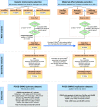Fetal genome predicted birth weight and polycystic ovary syndrome in later life: a Mendelian randomization study
- PMID: 37351103
- PMCID: PMC10282929
- DOI: 10.3389/fendo.2023.1140499
Fetal genome predicted birth weight and polycystic ovary syndrome in later life: a Mendelian randomization study
Abstract
Associations between lower birth weight and higher polycystic ovary syndrome (PCOS) risk have been reported in previous observational studies, however, the causal relationship is still unknown. Based on decomposed fetal and maternal genetic effects on birth weight (n = 406,063), we conducted a two-sample Mendelian randomization (MR) analysis to assess potential causal relationships between fetal genome predicted birth weight and PCOS risk using a large-scale genome-wide association study (GWAS) including 4,138 PCOS cases and 20,129 controls. To further eliminate the maternally transmitted or non-transmitted effects on fetal growth, we performed a secondary MR analysis by utilizing genetic instruments after excluding maternally transmitted or non-transmitted variants, which were identified in another birth weight GWAS (n = 63,365 parent-offspring trios from Icelandic birth register). Linkage disequilibrium score regression (LDSR) analysis was conducted to estimate the genetic correlation. We found little evidence to support a causal effect of fetal genome determined birth weight on the risk of developing PCOS (primary MR analysis, OR: 0.86, 95% CI: 0.52 to 1.43; secondary MR analysis, OR: 0.86, 95% CI: 0.54 to 1.39). In addition, a marginally significant genetic correlation (rg = -0.14, se = 0.07) between birth weight and PCOS was revealed via LDSR analysis. Our findings indicated that observed associations between birth weight and future PCOS risk are more likely to be attributable to genetic pleiotropy driven by the fetal genome rather than a causal mechanism.
Keywords: Mendelian randomization; birth weight; fetal genome; genetic pleiotropy; polycystic ovary syndrome.
Copyright © 2023 Liu, Gan, Zhang, Cui, Tao, Zhang and Zhao.
Conflict of interest statement
The authors declare that the research was conducted in the absence of any commercial or financial relationships that could be construed as a potential conflict of interest.
Figures



Similar articles
-
Maternal Polycystic Ovary Syndrome and Offspring Birth Weight: A Mendelian Randomization Study.J Clin Endocrinol Metab. 2022 Mar 24;107(4):1020-1029. doi: 10.1210/clinem/dgab843. J Clin Endocrinol Metab. 2022. PMID: 34849988
-
Causal relationships exist between polycystic ovary syndrome and adverse pregnancy and perinatal outcomes: a Mendelian randomization study.Front Endocrinol (Lausanne). 2024 Jun 28;15:1327849. doi: 10.3389/fendo.2024.1327849. eCollection 2024. Front Endocrinol (Lausanne). 2024. PMID: 39006363 Free PMC article.
-
Is there a shared genetic basis and causal relationship between polycystic ovary syndrome and psychiatric disorders: evidence from a comprehensive genetic analysis.Hum Reprod. 2021 Jul 19;36(8):2382-2391. doi: 10.1093/humrep/deab119. Hum Reprod. 2021. PMID: 34051085
-
Causes and Consequences of Polycystic Ovary Syndrome: Insights From Mendelian Randomization.J Clin Endocrinol Metab. 2022 Feb 17;107(3):e899-e911. doi: 10.1210/clinem/dgab757. J Clin Endocrinol Metab. 2022. PMID: 34669940 Free PMC article. Review.
-
Childhood, adolescent, and adulthood adiposity are associated with risk of PCOS: a Mendelian randomization study with meta-analysis.Hum Reprod. 2023 Jun 1;38(6):1168-1182. doi: 10.1093/humrep/dead053. Hum Reprod. 2023. PMID: 37015099 Free PMC article.
Cited by
-
[Research Progress in the Pathogenesis of Polycystic Ovary Syndrome].Sichuan Da Xue Xue Bao Yi Xue Ban. 2024 Jul 20;55(4):1049-1054. doi: 10.12182/20240760208. Sichuan Da Xue Xue Bao Yi Xue Ban. 2024. PMID: 39170002 Free PMC article. Review. Chinese.
References
Publication types
MeSH terms
LinkOut - more resources
Full Text Sources
Medical

